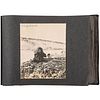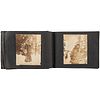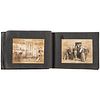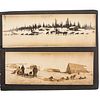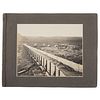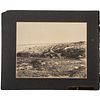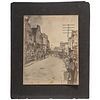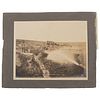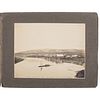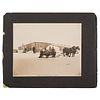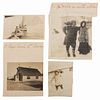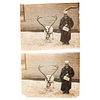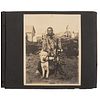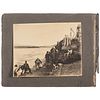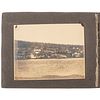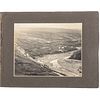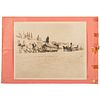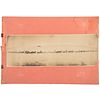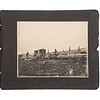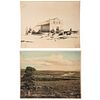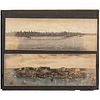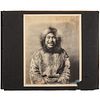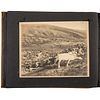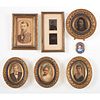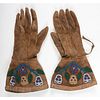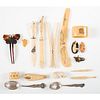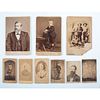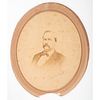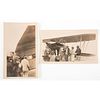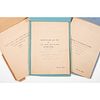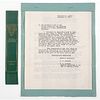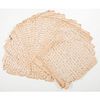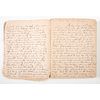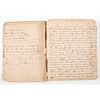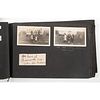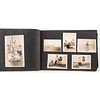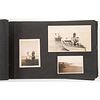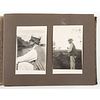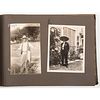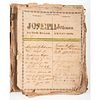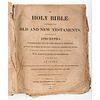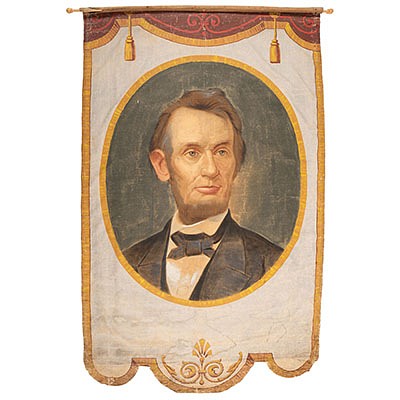[ALASKAN GOLD RUSH]. William Steele West (1872-1941) and family, extensive archive of photographs, diaries, correspondence, and personal items. [Ca 19
About Seller
6270 Este Ave.
Cincinnati , OH 45232
United States
With offices in Cincinnati, Cleveland and Denver, Cowan’s holds over 40 auctions each year, with annual sales exceeding $16M. We reach buyers around the globe, and take pride in our reputation for integrity, customer service and great results. A full-service house, Cowan’s Auctions specializes in Am...Read more
Two ways to bid:
- Leave a max absentee bid and the platform will bid on your behalf up to your maximum bid during the live auction.
- Bid live during the auction and your bids will be submitted real-time to the auctioneer.
Bid Increments
| Price | Bid Increment |
|---|---|
| $0 | $25 |
| $500 | $50 |
| $1,000 | $100 |
| $2,000 | $250 |
| $5,000 | $500 |
| $10,000 | $1,000 |
| $20,000 | $2,500 |
| $50,000 | $5,000 |
| $100,000 | $10,000 |
About Auction
Jun 25, 2021
The June 25 American Historical Ephemera and Photography Auction features an exciting assemblage of 18th-early 20th century material, including Civil War archives, Early Photography, Western Americana, Autographs and Manuscripts, and more. Cowan's Auctions dawnie@cowans.com
- Lot Description
Extensive archive of over 750 photographs, documents, manuscripts, and ephemera identified to William S. West and his family, highlighted by 260+ items documenting the family’s time in Alaska between 1900-1909, including: 2 folio albums containing approx. 86 large format silver gelatin photographs, most 8 x 10 in. or 4 ¼ x 12 ½ in., as well as 28 personal snapshots, 3 x 5 in. or smaller, many mounted on 10 3/4 x 13 ¼ in. pages (many disbound from one album that includes cover but is no longer intact). The majority of the large format photographs are titled and credited or copyrighted in the negative to A.B. Kinne, Nome, Alaska, and many are dated 1904. Some images also include penciled notations written by West or a member of his family. The photographs provide a study of Alaskan life at the turn of the century, and include lumber, railroad, and mining operations, many involving the Wild Goose Company, striking landscape and city views, native inhabitants, and wildlife. Personal photographs of the Wests, their home, and their cat “Texas” are also included. List of titles available upon request. – Small album containing approx. 125 silver gelatin photographs, 3 ½ x 4 ½ in., mounted recto/verso on 5 ½ x 7 in. pages, many with inked notations. A personal album documenting the Wests’ time in Alaska, providing several views of Mr. and Mrs. West, their daughter Margaret, friends and associates, native inhabitants, pets, wildlife, and mining scenes. A small number of photos also capture the family’s time in Texas. – 4 real photo postcards and 2 printed postcards postmarked Unalaska, Nome, and Ketchikan.
Composition book, 7 1/2 x 9 1/2 in., containing 54pp of highly detailed manuscript entries from William West describing the winter of 1900-1902 at Ophir Creek in the Council City (formerly Eldorado) Mining District of Alaska. West provides details regarding his house, clothing, snow shoes purchased from a native, dogs, and more. He was hired as bookkeeper and cook. He did a bit of hunting, but in the winter, the only available game was ptarmigan. The first entries were written through early July: “It snowed some on July 2nd and that completes the chain, it has snowed on Ophir Creek every month beginning August 13, 1900.” The next section begins at Seattle, Washington, 25 April 1902, Took passage on SS Nome City bound for Cape Nome. He describes being frozen in the ice of the Bering Sea in June while checking on other mining claims. The back of the composition book contains poems written by West.
Additional loose pages are tucked into the back of the book, but rough condition makes content difficult to discern.
3 typed journals from William West, the first, a transcribed version of West’s manuscript journal from Ophir Creek referenced above (26 pp).
The second typed journal covers his journey from [Nome] Alaska to San Francisco 30 October to 21 November 1901 (10pp). It includes a list of crew and equipment, then passengers. Pencil note indicates “not licensed to carry” [passengers]. Second note after the list: “all signed [illeg] articles as able seamen.”
West describes going aboard the Barbara Hernster and securing his bunk where he laid down for a rest. “The crew of the Barbara, including the captain, had been on shore leave and had provided themselves with considerable liquid refreshment, so when they came aboard a fight was started.” Next morning he describes the Captain and several seamen were “bunged up.”
The group then sailed toward Dutch Harbor all day. The boom broke on the fore sail and lost the top sail, but the sailors fixed them. “After dinner went to Unalaska and there found that the captain of the Ralph J. Long had deserted the ship and left 125 destitute passengers, and a tough looking lot they were. These passengers were mainly drunken ‘bums’ who, not having sufficient money to pay their fare out on a regular steamer, had been herded together in this schooner and when they landed at Dutch Harbor they all proceeded to get drunk and take possession of the place. The captain deserted the boat and caught a steamer that was leaving Dutch Harbor shortly for the states, and when we arrived all the inhabitants of Dutch Harbor and Unalaska – few in number – were very much excited as they thought they would have all these unwelcome guests on them for the winter, the Barbara being the last boat out of Nome, so on the night of the 6th we took turns guarding the Barbara for fear we would be boarded, notwithstanding Mr. Lane got all on board to subscribe to their relief and secured for them the services of a navigator who promised to take their schooner to Seattle, and we had the Alaskan Exploration company outfit them with provisions for which we paid and took a bottomry bond on the boat.”
“One of the boys got a little drunk and got lost in the hills, so we formed a little searching party and, armed with lanterns, started out to find him We separated after getting on his trail and I was fortunate enough to find him lying on the side of a hill with the snow fast covering him. I signalled the rest and we got him aboard ship about ten o’clock..”
They into a storm that lasted a couple days. “The wind died down last night about 12 o’clock. I was on deck about 9p.m. and saw the most beautiful phosphorescent sea I have ever seen, it beggar[e]d description.” The next day was Mr. Lane’s (president of Wild Goose Mining & Trading Co) birthday; West writes out the poem he composed for Lane. They reached San Francisco a few days later.
The third typed journal describes West’s journey from Seattle to Nome, 10 May to 28 May 1909 (6pp). He refers to a man in the room next to him that broke , and he hopes it is not smallpox. He passed Bella Bella, the largest Indian village on the coast; “Years ago the Hudson Bay company tried to levy a tax on the indians for occupying the ground and they simply moved away, and the town is named New Bella Bella and about one mile from the old town.” West talks about picking up a buck deer that was swimming across Granville Channel and brought him on deck, but never says the animal’s eventual fate.
He stopped at Ketchikan, then anchored at Craigshead before passing through the Wrangel Narrows. He describes passing a ship wreck on which someone painted “Drink Yellowstone Whiskey,” and someone else added “I did.”
West passed Petersburg, then went through Cross Sound and Icy Strait where there was a lot of floating ice from Muir Glacier. He then came out into Cape Spencer and Cape St. John, passed Mt. La Perouse and Mt Crillion, and sighted Mt. St. Elias, Cape St. Elias and Montague Island. He was about 100 miles from Seward at one point, then entered Resurrection Bay and docked at Seward about an hour later, which had the best game country he had heard of yet. West ran past Cook’s Inlet then Kodiak Island. He put into Sand Point and started fishing. He passed a volcano or Pavlof Bay. He could not see volcanic activity, but “we may sight a volcano or two this afternoon as there are more than 250 along the coast.” He then passed through Unanmack Pass and arrived at Dutch Harbor.
At one point, West entered a Russian church, mentioning the all-male choir singing Greek hymns (“anthems”). West references some Japanese poachers who were arrested the previous July with illegal fur seal pelts on board; their vessels were still in the harbor, the men were in prison. West describes sailing through lots of pack ice, seeing many walruses along the way. He tried to shoot one of the walruses, but conditions were too dark for accuracy.
Also included are typed copies and one manuscript letter dealing with mine workings – which flumes are running at which claims, the effects of weather (such as early snow or early melting) on the mining operations, and more.
Additional items from the Wests’ time in Alaska include 13 walrus tusk objects, almost certainly souvenirs from Alaska, incl. fossilized walrus tusks (3), one with 14K gold accent, napkin rings (2), one with “W,” letter opener, needle case, awl, and heart pendant. – 2 souvenir spoons. – Metis beaded buffalo hide gauntlets.
[With:] Photographs, correspondence, and other objects documenting the life and experiences of West and his family in Texas and beyond. Additional items of note include:
60+ loose photographs, including cased images, CDVs, cabinet cards, large format photographs, some housed in frames, and personal snaphots of William West, his father Charles Shannon West, his mother Florence Randolf DuVal West, his wife Josephine Johnson, his daughter Margaret Anna West, and other relatives and friends. Many early CDVs and cabinet cards of members of the West family are credited to H.R. Marks of Austin, Texas. Highlights include a cabinet card of a group of young men in hunting gear, many armed with shotguns, posed with a dog, with each subject, including a young “Billie West” identified on verso, collectively described as “Our camping out club, Austin, Texas” (loss to lower right corner of print and mount, additional edge and corner wear). – CDV of a young man wearing a curious uniform identified on mount below image as “Knight of the Golden Horse-Shoe,” with additional ID on verso, “Fred S. Thomson, Texas” (toning, soiling, spotting). – Several formal studio portraits of West throughout his life, including shoulder-length portrait of West with “whirling log” pin on his tie, credited to Nowell, Nome, Alaska.
Album containing approx. 124 silver gelatin photographs of the West family, mostly in Texas, including several images of William fishing.
Album containing approx. 215 silver gelatin photographs that may have been compiled by Margaret West based on the period notations. A number of recreational activities are documented, including swimming at the beach, fishing, sailing, horseback riding, and playing with friends.
4 oval printed formal family portraits of West family members.
Brooch with miniature portrait believed to be Margaret West, signed by L. Penet [Lucien Penet].
3 silver gelatin photographs showing William West and associates posed near an airplane, including 2 ¾ x 4 ½ in. photograph showing Charles Lindbergh at Brownsville Municipal Airport.
Real photo postcard showing President-elect Warren G. Harding at Point Isabel, Texas, November 1920, and accompanying photograph of a group of people, incl. who appears to be William West, on a sailing boat nicknamed “Oh, You Kid,” with verso caption, “Pres. Elect Harding on visit to Point Isabel.”
[Also with:] Assortment of books, documents, correspondence, and more.
Holy Bible. Philadelphia: M. Carey & Son, 1817. 8 1/2 x 11 in., 3 1/2 in thick (very rough condition). Loose pages in front refer to Johnson family, with occasional note tucked between pages.
Portfolio with suede covers identified to “W.S. West / Brownsville, Texas” in lower right corner of front board, containing assortment of documents, among them: TLS to “Bud” (Duval West), 14 August 1940 on West & Hightower, Attorneys at Law, Brownsville, Texas letterhead. -- TLS to Duval West 9 February 1942, concerning William West’s affairs, signed by R.A Hightower (West had died). -- ALS on West & Hightower letterhead, 3 January 1941 to Duval West, mentions he had a mild heart attack the previous week, but felt OK at this time. -- ALS, William West to Margy, Brownsville 23 October 1941. -- ALS to Margaret, San Antonio, 6 February 1942 from Bud, sympathy for death of her father, Will. -- Copy of resolution by Bar in Cameron County, Texas expressing the sorrow at the death of William West.
Curious group of 19th century legal documents: indenture on vellum 13 1/4 x 28 in., Philadelphia, 1803 -- 14 legal documents, most land indentures from Ohio and dating to the first half of the 19th century.
Baby book identified to Joe Anna Goodrich – b. 31 July 1936; parents Emmette K. Goodrich Jr. and Margaret West Goodrich, William West’s (only) daughter.
Case, Lafayette Wallace, MD. The Goodrich Family in America. A Genealogy…. Chicago: Fergus Printing Company, 1889. 8vo, blue cloth, no dj, 417, ii pp.
William Steele "Bill" West was born in Austin, Texas 21 May 1872. After graduating from the University of Texas and Cumberland University in Tennessee he became associated with the American National Exchange Bank at Austin. After three years as manager for the Water and Light Department, he became manager of the Wild Goose Placer Mining Company in Alaska, a Guggenheim gold property. While working in Alaska, he married Josephine "Joe" Johnson, daughter of a distinguished Austin family. They had one daughter, Margaret Anna West Goodrich. After spending nearly a decade in the placer mining business, West settled in Brownsville, Texas and began his law practice. He also was active in politics, becoming a member of the Republican State Executive Committee and a friend of many US Presidents. He was entertained at the White House under Presidents Harding, Coolidge, and Hoover. West was nominated for Attorney-General of Texas by his party. He was an officer and director of many corporations, including the First National Bank of Brownsville, The Rio Grande Valley Gas Company and the Rio Grande Valley Bridge Corporation. West was a member of the Rotary Club, a Mason, and an Elk, and was quietly generous in his support of the needy. - Shipping Info
-
SHIPPING & PICKUPS Cowan’s Cincinnati Office offers an in-house, full-service shipping department which is unparalleled in the auction industry. Shipping costs are provided with your finalized invoice 24-48 hours after auction. For furniture and oversized items, we recommend using third-party services. For more information, contact cowansshipping@hindmanauctions.com. NOTE: All pickups and preview are by appointment only. To make an appointment, please call 513-871-1670 or email cincinnati@hindmanauctions.com Buyers are required to pay for all packing, shipping and insurance charges. Overseas duty charges are the responsibility of the successful Bidder. Be aware that for larger and/or valuable items, shipping charges can be substantial. - Shipping charges include insurance for your order while in transit. If you have private insurance we will adjust your charge to include only packing and shipping. - Please allow 14 – 21 days after payment to package and ship your purchase as carefully as possible.
-
- Buyer's Premium



 EUR
EUR CAD
CAD AUD
AUD GBP
GBP MXN
MXN HKD
HKD CNY
CNY MYR
MYR SEK
SEK SGD
SGD CHF
CHF THB
THB![[ALASKAN GOLD RUSH]. William Steele West (1872-1941) and family, extensive archive of photographs, diaries, correspondence, and personal items. [Ca 19](https://s1.img.bidsquare.com/item/l/8590/8590639.jpeg?t=1LMYw6)
![[ALASKAN GOLD RUSH]. William Steele West (1872-1941) and family, extensive archive of photographs, diaries, correspondence, and personal items. [Ca 19](https://s1.img.bidsquare.com/item/s/8590/8590639.jpeg?t=1LMYw6)
